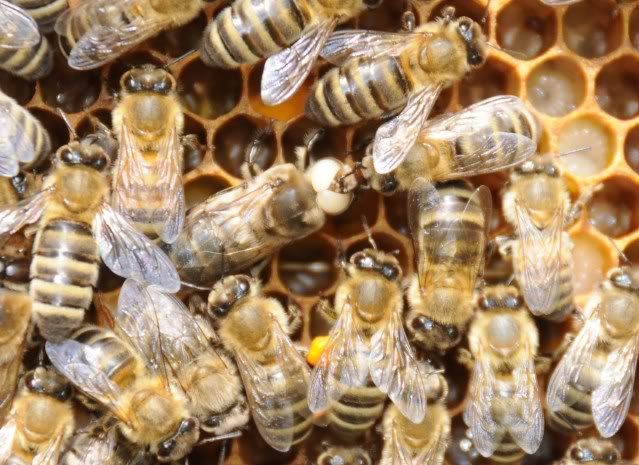- Joined
- Jan 13, 2015
- Messages
- 7,641
- Reaction score
- 665
- Location
- Bedfordshire, England
- Hive Type
- Langstroth
- Number of Hives
- Quite a few

Yes it is an eye pigment mutation, pretty rare, but well known. Sometimes it can be a single eye that is white. Several other eye colour mutants also exist,
Alas, although your white eyed drones will live a long and happy life in the hive they are blind.
in the hive they are blind.
mutations are taking place all the time with most not noticed. Survival of the fittest?
I'm more interested in how widely spread it is. Has anyone seen it in real life?
I have never seen blind white eyed Drones... wonder if this is the effect of yet another virus that has flown in from afar?
Isn't it interesting that they were in a swarm though?
The swarm was captured last year, the blind drones are only being seen this year. There probably weren't any seen last year as they got left behind.
No. The photo was taken last year.
I have wondered about it for a long time
Sorry...I am always doing that too.You managed to quote me on an accidental premature reply oooerr mssuss. The albino eye coverage from your photos doesn't seem to be 100%. So they may retain sufficient vision to have flown with a swarm and even fly around a bit. Lots of mutations can give this patchy phenotype, but interestingly, usually in a heterozygous background.
Yes. In one colony which, for background, was headed by a daughter out of one of the 'buckfast x cecropia' queens.
Did you see it in either of these colonies before the cross? It would be interesting to know where it came from.
Not seen it since that colony's queen was superceded either.
Lots of mutations can give this patchy phenotype, but interestingly, usually in a heterozygous background.
Not quite. Queens are diploid, two copies of each gene. One of each is contributed to each drone. So a dominant/recessive pair of genes in the queen will produce recessive in half the drones they lay. That assumes it's a single gene responsible for a specific trait, it could be dependent on other genes too and the observation of various colours, yellow or green and red as well as white for instance suggests the eye pigmentation is more complex... My understanding is that it is a caused by a gene, and not a virus. If it is a recessive gene, it would be expressed in all drones from that queen (excluding variation) because there is no suppression of the recessive with a dominant gene from a drone. Drones express all of their characteristics because they only have 16 chromosomes.

I see white eyed drones every summer, but I have very many colonies in my apiaries. I've seen the green eyes a few times but never the red.
Enter your email address to join: